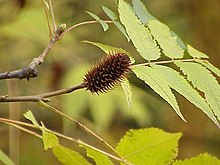
The Juglandaceae are a plant family known as the walnut family. They are trees, or sometimes shrubs, in the order Fagales. Members of this family are native to the Americas, Eurasia, and Southeast Asia.
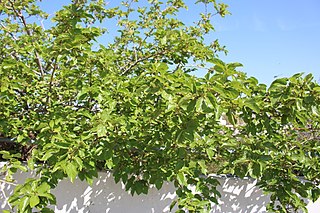
Morus alba, known as white mulberry, common mulberry and silkworm mulberry, is a fast-growing, small to medium-sized mulberry tree which grows to 10–20 m (33–66 ft) tall. It is generally a short-lived tree with a lifespan comparable to that of humans, although there are some specimens known to be more than 250 years old. The species is native to China and India and is widely cultivated and naturalized elsewhere.

Salix purpurea, the purple willow, purpleosier willow, or purple osier, is a species of willow native to most of Europe and western Asia north to the British Isles, Poland, and the Baltic States.

Pterocarya, often called wingnuts in English, are trees in the walnut family Juglandaceae. They are native to Asia. The botanic name is from Ancient Greek πτερον (pteron) "wing" + κάρυον (karyon) "nut".
Carya sinensis is a species of tree native to southwestern China and northern Vietnam, in the hickory genus Carya. It is sometimes called Chinese hickory or beaked hickory. It is closely related to Carya kweichowensis.

Amentotaxus is a genus of conifers (catkin-yews) comprising five species, treated in either the Cephalotaxaceae, or in the Taxaceae when that family is considered in a broad sense. The genus is endemic to subtropical Southeast Asia, from Taiwan west across southern China to Assam in the eastern Himalaya, and south to Vietnam. The species are evergreen shrubs and small trees reaching 2–15 m tall.
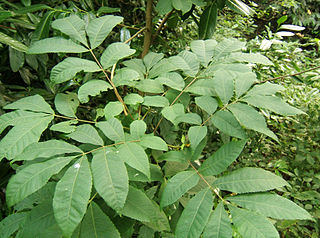
Carya cordiformis, the bitternut hickory, also called bitternut, yellowbud hickory, or swamp hickory, is a large pecan hickory with commercial stands located mostly north of the other pecan hickories. Bitternut hickory is cut and sold in mixture with the true hickories. It is the shortest-lived of the hickories, living to about 200 years.

Betula populifolia is a deciduous tree native to eastern North America.

Quercus dentata, also called Japanese emperor oak or daimyo oak is a species of oak native to East Asia. The name of the tree is often translated as "sweet oak" in English to distinguish it from Western varieties. It is placed in section Quercus.

Ostrya virginiana, the American hophornbeam, is a species of Ostrya native to eastern North America, from Nova Scotia west to southern Manitoba and eastern Wyoming, southeast to northern Florida and southwest to eastern Texas. Populations from Mexico and Central America are also regarded as the same species, although some authors prefer to separate them as a distinct species, Ostrya guatemalensis. Other names include eastern hophornbeam, hardhack, ironwood, and leverwood.

Acer mandshuricum, the Manchurian maple, is a species of maple native to China, Korea and Russia.
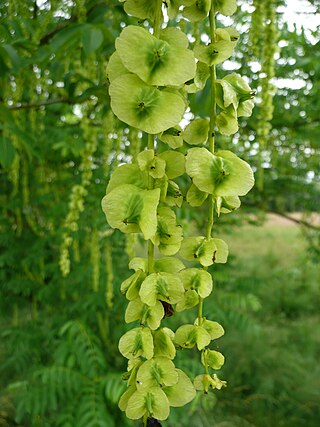
Pterocarya fraxinifolia is a species of tree in the Juglandaceae family. It is commonly known as the Caucasian wingnut or Caucasian walnut. It is native to the Caucasian region Armenia, Azerbaijan, Georgia, Iran, Russia, Ukraine and Turkey. It was introduced to France in 1784, and to Great Britain after 1800.

Salix magnifica is a species of willow in the family Salicaceae. It is endemic to Sichuan in southwestern China, where it grows at high altitudes of 2,100–3,000 m above sea level. It is threatened by habitat loss.

Cyclocarya is a genus of flowering plants in the family Juglandaceae, comprising a single species Cyclocarya paliurus, formerly treated in the genus Pterocarya as Pterocarya paliurus. It is native to eastern and central China.

Juglans mandshurica, also known as Monkey nuts, or Tigernut, is a deciduous tree of the genus Juglans, native to the Eastern Asiatic Region. It grows to about 25 m.

Corylus heterophylla, the Asian hazel, is a species of hazel native to eastern Asia in northern and central China, Korea, Japan, and southeastern Siberia.

Platycarya is a genus of flowering plants in the family Juglandaceae native to eastern Asia in China, Korea, and Japan.

Salix triandra, with the common names almond willow, almond-leaved willow or black maul willow, is a species of willow native to Europe and Western and Central Asia. It is found from south-eastern England east to Lake Baikal, and south to Spain and the Mediterranean east to the Caucasus, and the Alborz Mountains. It usually grows in riparian habitats, on river and stream banks, and in wetlands.
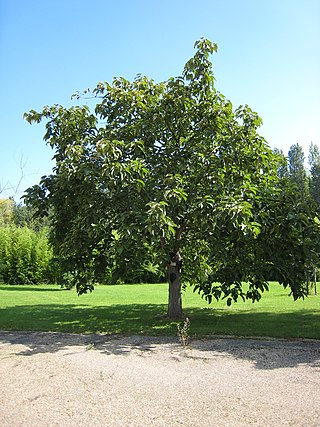
Populus lasiocarpa, commonly called the Chinese necklace poplar, is a species of poplar native to humid forests of China. It is closely related to Populus wilsonii, Wilson's poplar.

Pedunculagin is an ellagitannin. It is formed from casuarictin via the loss of a gallate group.
